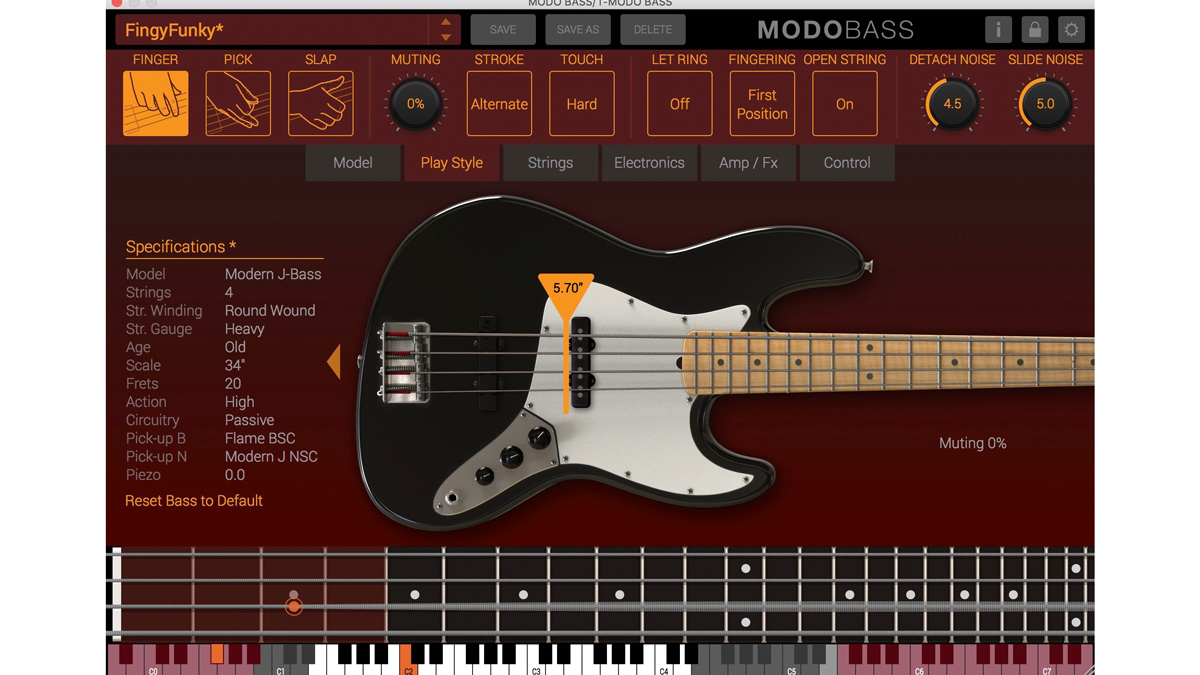MusicRadar Verdict
It might seem too good to be true, but Modo Bass is the real deal, bringing stunningly lifelike electric bass to the studio without a sample to be seen.
Pros
- +
Easy to use .
- +
All the flexibility of physical modelling.
- +
Sounds just like the real thing(s).
- +
Fabulously playable.
Cons
- -
Mono chorus and delay.
- -
No fretless or six-string options.
MusicRadar's got your back
For the computer musician looking to use electric bass in their productions, the only options to date have been to either record the real thing or fire up a sample-based instrument.
With their new alternative, IK Multimedia is claiming a world first: eight years in development, Modo Bass (VST/AU/AAX/ standalone) puts physically modelled emulations of 12 classic electric bass guitars at your fingertips, along with the techniques a bassist would employ to play them. The big question, then, is whether the malleability of physical modelling in this case comes at the expense of sonic realism...
A la Modo
Being a synth, Modo Bass doesn’t require anywhere near the hard drive space devoured by the average muiltisampled library - the installer is a svelt 170MB. The majority of the interface is taken up by a representative graphic of the bass being modelled, or the amp and pedalboard, or the keyswitching layout, depending on which of the six tabbed pages you’re on.
The control array at the top changes to reflect the currently selected tab - MIDI CC-assignable parameters in the Control tab, for example, or pickup and tone shaping options in the Electronics tab.
At the bottom of the GUI, the interactive fretboard and keyboard enable moused play and show the left hand fingering and string plucks in real time. You can let Modo Bass make left hand string/fret choices for you, or use the keyswitches at the top of the keyboard to force your own.
Modo Bass includes a sizeable preset library, so getting busy with it can be as simple as loading one and triggering it from your MIDI keyboard or piano roll editor. Three keyswitchable playing styles are onboard - Finger, Pick and Slap - while the other controls in the Play Style tab let you adjust the ‘touch’ strength, fingering (index, middle or alternating), pick direction (up, down or alternating), slap style (all slap, all pull, or slap with automatic pull for notes over a specified velocity), left hand fretboard positioning, slide and release noise, amount of string muting applied and more. The right hand playing position, meanwhile, is shifted between the bridge and neck by dragging the orange marker on the central graphic.
The 14 keyswitches (toggling many of the Play Style options, plus Ghost note, Hammer On/Pull Off, Harmonics, etc) are annotated in the Control tab on an interactive graphical keyboard. While the keyswitches can’t be edited, the assignment of MIDI CCs to Bend, Slide, Muting, Pluck Position, Vibrato and other performance parameters can, making MIDI controller linkage a straightforward, painless process.
Every one of the 12 modelled bass guitars at the heart of Modo Bass is a classic in its own right, between them delivering a comprehensive history of bottom-heavy tones. And although you can mix and match their innards as you see fit in the Electronics page, bringing active circuitry to previously passive-only instruments and experimenting with pickup pairings, they all sound fantastic in their default configurations.
As you’d expect, both of Fender’s legendary lines are represented in the shape of the 60s and 70s Precision, and 70s and Modern Jazz models. Beyond those stalwarts, the other eight can be roughly divided into ‘vintage’ (50s, 60s and 70s) and ‘modern’ (80s) categories, the former consisting of the Gibson EB-0, Rickenbacker 4003, Gibson Thunderbird and Höfner Violin, the latter taking in the Music Man StingRay 5, Warwick Streamer, Ibanez Soundgear and Yamaha TRB5P.
It’s a quality collection, for sure - these are some of the most influential and lauded basses of all time, and any bassist would kill to own all of them.
Bass in the place
When you want take advantage of the physical modelling engine to design your own bass, the first thing to do is select one of 12 guitars in the Model page (see The dirty dozen). This individually models the body, strings and electronics of the chosen instrument, the last two of which are editable in the Strings and Electronics tabs.
The strings can be set to four (with drop D option) or five in number, switched between round and flat wound, and light, medium and heavy gauge, and even aged - Old, New or Broken In, influencing sustain and brightness. The action can be set to three heights, too, for tonal and fret noise variation.
Each bass model comes with its own bridge and neck pickups (as well as a piezo under the bridge), but both are freely swappable in the Electronics tab for any from the full list of 20 single coils and humbuckers, and independently positionable anywhere between bridge and neck. The Tone knob offers basic frequency tilting, while turning on Active circuitry unlocks the Bass, Middle and Treble EQ knobs.
Finally, Tube and Solid State amp models are available in the Amp/FX tab, each with its own EQ and other controls, alongside a series of four effects ‘pedals’, each hosting your choice from seven processors - Envelope Filter, Delay, Distortion, Octaver, Graphic EQ, Chorus and Compressor. The amplified signal is mixed with the DI signal at the final output.
Highs and lows
Modo Bass squarely hits the mark when it comes to realistic fingered, picked and - to a slightly lesser extent - slap bass emulation, sounding easily close enough to the real thing as to be indistinguishable in the mix, right down to the fret and string noise.
The well-designed interface makes tweaking sound, response and instrument characteristics easy, and programming or playing authentically ‘human’ b-lines quickly becomes intuitive, thanks to the excellent performance controls and keyswitching setup. On the down side, the mono chorus and delay effects are a tiny blemish; fretless and six-string configurations would have made for tasty icing on an already delicious cake; and it’s quite a lot more expensive than the average sampled bass library.
Ultimately, though, even the most cynical of music production traditionalists would be hard pressed to find fault with Modo Bass’ superb electric bass modelling, which, when programmed and manipulated properly, is every bit as sonically effective as its multisampled equivalents, and far more versatile. IK may just have changed the low-end game.
Computer Music magazine is the world’s best selling publication dedicated solely to making great music with your Mac or PC computer. Each issue it brings its lucky readers the best in cutting-edge tutorials, need-to-know, expert software reviews and even all the tools you actually need to make great music today, courtesy of our legendary CM Plugin Suite.

“If it wasn’t for that song, that would have been the end of the band”: How one track’s sudden gear-switch led Coldplay into their imperial phase

“He was like, ‘You’ve got it all wrong, man": Mumford & Sons reveal what Neil Young told them about the way they were approaching their live shows and album recordings

How to write a ‘sticky’ hit: Pure luck can put you in the charts, but sticking around to make the big bucks needs pure science











